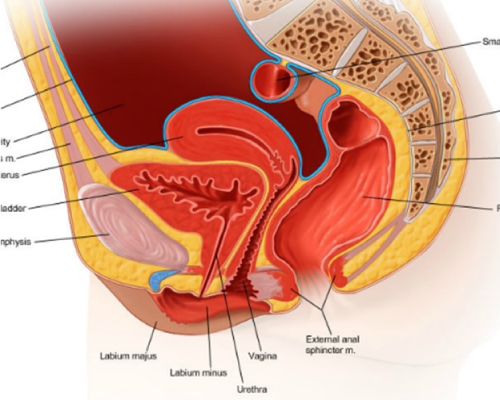What are the pelvic floor muscles?
The floor of the pelvis is made up of layers of muscle and other tissues. These layers stretch like a hammock from the tail bone at the back to the pubic bone in front. A woman’s pelvic floor supports the bladder, the womb (uterus) and the bowel. The urethra (front passage), the vagina (birth canal) and the rectum (back passage) pass through the pelvic muscles. The pelvic floor muscle has an important role in bladder and bowel control and sexual sensation.
We have control over the pelvic muscles. Like other muscles in the body, exercise strengthens them when they are weak.
Why the pelvic floor muscles may weaken?
The pelvic floor muscles can be weakened by:
- Pregnancy and childbirth;
- Continual straining to empty your bowels (constipation);
- Persistent heavy lifting;
- A chronic cough (such as smoker’s cough or chronic bronchitis and asthma);
- Being overweight;
- Changes in hormone levels at menopause (change of life);
- Lack of general fitness.
What are the benefits of pelvic floor exercises?
It is important for women of all ages to maintain pelvic floor muscle strength.
Women with stress incontinence, that is, those who regularly lose urine when coughing, sneezing or exercising, especially should learn these exercises.
For pregnant women, this helps the body to cope with the increasing weight of the baby. Healthy, fit muscles before child birth will recover more fully after the child birth.
As women grow older it is important to keep the pelvic floor muscle strong because at menopause the muscles may change and weaken. A pelvic floor exercise routine helps to minimise the effects of menopause on pelvic support and bladder control.
Pelvic floor exercises may be also useful in conjunction with a bladder training program.
How to contract the pelvic floor muscles?
This first thing to do is to correctly identify the muscles that need to be exercised.
- Sit, or lie comfortably with the muscles of your thighs, buttocks and abdomen relaxed.
- Tighten the ring of muscle around the back passage as if you are trying to control diarrhea or wind. Relax it. Practice this movement several times until you are sure you are exercising the correct muscle. Try not to squeeze your buttocks.
- When you are passing urine, try to stop the flow mid-stream, and then restart it. Only do this to learn which muscles are the correct ones to use and then do it only once a week to check your progress.
- If you feel comfortable, another way to check that you are using the correct muscle is to place one or two fingers in your vagina then squeeze the pelvic muscles. Squeezing the muscle will grip the fingers. If the muscles are very weak, you may not feel much of a grip until they improve with exercise. Strong muscles will produce a squeezing and drawing up effect.
Doing pelvic floor exercises
Now that you can feel the muscle working, exercise it by:
- Each exercise consists of squeezing and relaxing your pelvic floor muscles. Squeeze the muscles for 5 seconds and relax the muscles for 5 seconds. Each squeeze and relaxation counts as one exercise.
- You should build to 10 second contractions. Remember to squeeze and count slowly "1-2-3-4-5-6-7-8-9-10" and relax the muscle and count "1-2-3-4-5-6-7-8-9-10."
- Do this exercise in each position every day; ten exercises lying, ten sitting, and ten standing. What is crucial is that you develop the habit of doing the exercises every day.
- Do this exercise 60 times a day, divided in 2 sessions of 30 each, one in the morning when you get up and the other at night.
While doing the exercises:
- DO NOT hold your breath
- DO NOT push down instead of squeezing
- DO NOT tighten your tummy, buttocks or thighs.
Making the exercises part of your daily routine.
Once you have learned how to do these exercises, they can be done during everyday activities. Such activities might include:
- Showering
- Brushing your teeth
- After urinating
- Watching T.V.
- Stopped at traffic lights in the car
- Putting on the kettle
It might be helpful if you do these exercises at least five times every day.
Other things you can do to help your pelvic floor muscles
- Share the lifting of heavy loads
- Avoid constipation and prevent any straining during a bowel movement
- Seek medical advice for asthma and bronchitis to reduce sneezing and coughing.
- Keep your weight within the right range for your height and age.
If you find it difficult to do the exercises or you feel that you are not improving, don’t give up. Seek help from a health professional who specialises in this area.

